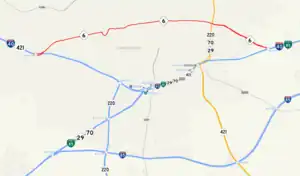North Carolina Highway 6 | ||||
|---|---|---|---|---|
 | ||||
| Route information | ||||
| Maintained by NCDOT | ||||
| Length | 8.5 mi[1] (13.7 km) | |||
| Existed | 1959[2]–2005[2] | |||
| Major junctions | ||||
| West end | ||||
| East end | ||||
| Location | ||||
| Country | United States | |||
| State | North Carolina | |||
| Counties | Guilford | |||
| Highway system | ||||
| ||||
North Carolina Highway 6 (NC 6) was an 8-mile-long (13 km) North Carolina state highway. It ran entirely in Guilford County and served primarily to connect Interstate 40 (I-40) and Business I-85 (I-85 Bus.) commuters in Greensboro. It was decommissioned in 2005.
Route description
The western terminus of NC 6 was at I-40 and U.S. Route 421 (US 421) at I-40's exit 216 in West Greensboro. The interchange only allowed for eastbound I-40 / southbound US 421 traffic to enter eastbound NC 6 and vice versa. From there, NC 6 traveled east Patterson Street with a speed limit of 45 mph (72 km/h), having an interchange with Merrit Drive, then to Patterson's only traffic signal at Holden Road. It continued east to Patterson's end at the Greensboro Coliseum with a speed limit of 35 mph (56 km/h). NC 6 then turned to the northeast and followed High Point Road onto Lee Street. NC 6 intersected O'Henry Boulevard (U.S. Route 29 (US 29), US 70, and US 220). The state highway continued east bending slightly to the south before ending at I-40 and I-85 Bus. at their exit 224.[1]
History
- 1934: NC 6 is commissioned as a short road located southwest of Lake Mattamuskeet in Hyde County.
- 1944: NC 6 is decommissioned and not replaced.
- 1947: A new NC 6 cuts off the corner between NC 49 and U.S. Route 52 in Stanly County. It replaced NC 49A.
- 1953: NC 8 is extended, moving NC 6.
- 1959: After moving to its current location, a couple of timely shifts allowed NC 6 to follow its current route.
- 2000s (decade): Recent changes have slightly altered the path of NC 6 around the I-40 interchange and the Greensboro Coliseum.[2]
- 2005: NC 6 decommissioned, signs not taken down until around May 2009.[2] As of October 2010, Google Maps still shows NC 6.[1]
- 2015: High Point Road and Lee Street, which was NC 6 east of Patterson Street, renamed Gate City Boulevard.[3]
Major intersections
The entire route was in Greensboro, Guilford County.
| mi[1] | km | Destinations | Notes | ||
|---|---|---|---|---|---|
| 0.0– 0.6 | 0.0– 0.97 | Exit 216 (I-40); eastbound I-40 exit / westbound I-40 entrance only | |||
| 1.1– 1.4 | 1.8– 2.3 | Merrit Drive | Interchange | ||
| 4.4– 4.6 | 7.1– 7.4 | Freeman Mill Road | Interchange | ||
| 5.1– 5.2 | 8.2– 8.4 | Martin Luther King Jr. Drive | Interchange; no access to eastbound NC 6 | ||
| 6.1– 6.4 | 9.8– 10.3 | Interchange | |||
| 8.3– 8.5 | 13.4– 13.7 | Eastern terminus of NC 6 | |||
| 1.000 mi = 1.609 km; 1.000 km = 0.621 mi | |||||
See also
References
- 1 2 3 4 Google (December 1, 2017). "Overview Map of Former North Carolina Route 6" (Map). Google Maps. Google. Retrieved December 1, 2017.
- 1 2 3 4 NCRoads Annex - NC 6 Archived 2010-11-25 at the Wayback Machine
- ↑ Gamm, Joe (May 21, 2016). "State to change highway signs to reflect Gate City Boulevard name change". Greensboro News & Record.
